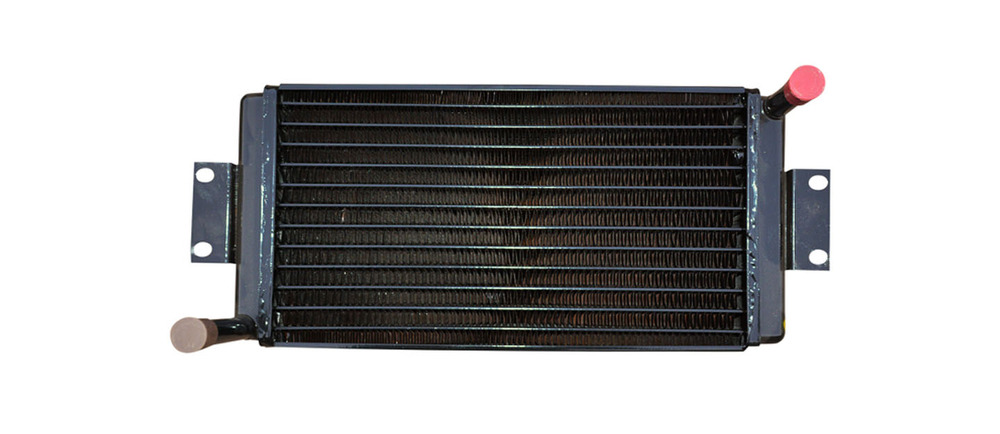Customizable Engine Oil Cooler is a solution tailored to specific engine requirements, operating environments, and design constraints. Instead of relying on generic OEM products, a customized oil cooler ensures:
- The perfect thermal load match
- Compactness and compatibility with the engine bay layout
- Material and coating selection based on environmental hazards (like salt, dust, vibration)
- Enhanced lifespan and minimal pressure drop
From race cars and marine vessels to industrial engines and defense vehicles, customizable oil coolers are the unseen warriors that maintain engine reliability even in the harshest conditions.
As engines become more powerful, compact, and efficient, the demand for smarter, adaptable cooling systems has grown. Among all thermal management components, the engine oil cooler plays a critical role in preventing thermal breakdown of lubricating oil, ensuring optimum engine performance, and protecting internal components.
Working Principle: How Engine Oil Coolers Function
The basic principle is heat exchange:
- Hot oil exits the engine and flows into the oil cooler.
- Heat is transferred from the oil to either air (via external fins) or a secondary fluid (typically water or coolant).
- The cooled oil returns to the engine sump or lubrication points.
This loop ensures that:
- Oil retains ideal viscosity for proper lubrication.
- It doesn’t reach thermal breakdown temperatures.
- Internal engine components stay protected from wear due to overheating.
A custom-designed cooler optimizes this process by considering engine speed, oil flow rate, expected heat load, and environmental conditions.
Deep Customization Parameters & Features
Choice of Cooling Medium
- Air-Cooled Oil Coolers
- Use ambient air to cool oil via exposed fins and tubes.
- Lightweight, no need for liquid plumbing.
- Perfect for motorcycles, race cars, or UAVs.
- Water-Cooled Oil Coolers
- Oil flows through a core surrounded by coolant (from the radiator loop).
- Faster cooling efficiency, works well in hot climates or for stationary engines.
- Ideal for marine engines, electric vehicles, or generator sets.
Thermal Load Capacity
Every engine has a unique oil heat rejection rate based on:
- Oil flow rate (liters per minute)
- Ambient temperature
- Engine power & RPM
- Altitude or environmental pressure
A custom cooler is designed to handle these thermal loads precisely, avoiding:
- Oversized coolers (which waste space and cost)
- Undersized units (which lead to overheating and oil failure)
Mounting & Orientation Flexibility
Custom oil coolers can be designed to fit:
- Horizontal or vertical mounting
- Side frame, chassis, or engine block attachment
- Remote mount with braided hoses in tight compartments
- Shock-resistant designs for high-vibration environments like boats or tanks
Mounting brackets, vibration isolators, and custom bolt patterns are all part of this design phase.
Inlet/Outlet Port Customization
Fittings can be tailored for:
- NPT, BSP, AN, JIC, or custom machined threads
- Weld-on or quick-disconnect fittings
- O-ring sealed or flange-type connectors for pressurized systems
- High-flow adapters for motorsport applications
You can also add multiple inlets/outlets, allowing loop-through cooling for combined systems (e.g., transmission + engine oil).
Smart Flow Control: Thermostatic Valves & Bypass
- A thermostatic valve opens only when oil reaches operating temperature (usually 70–80°C), avoiding overcooling.
- A bypass valve reroutes oil in case of blockage or low temperature—protecting engine startup conditions.
These can be integrated or installed inline as per custom needs.
Recent Innovations in Custom Oil Cooler Design
- 3D Printed Cooling Fins for intricate flow optimization
- Smart Sensors integrated into ports for real-time oil temp & pressure tracking
- Modular Cooler Assemblies that scale with performance upgrades
- Hybrid Oil + Coolant Exchangers for integrated thermal loops
- AI-driven CFD optimization for perfect fin geometry and flow resistance
Customizable Engine Oil Cooler is not just about temperature—it’s about total thermal control and application-specific reliability. Whether you’re tuning a race car, building a rugged generator for oil rigs, or developing high-altitude drones, customization gives you:
- The freedom to design for performance
- The confidence to operate in harsh conditions
- And the efficiency to save fuel, protect components, and reduce service downtime
In the future of thermal engineering, customization is not luxury—it’s necessity.

